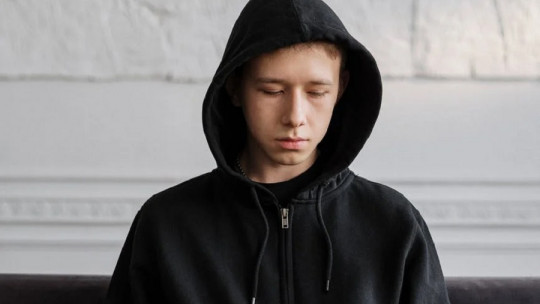
Adolescence and young adulthood are very turbulent periods in most people’s lives.
It is a moment of transition in which we have to form our individual identity, discover what interests us professionally, socially and sexually and we also have to face family demands although claiming our independence and individuality.
Although the majority overcome this period without major problems, others may experience it so overwhelmingly and also experience events that are harmful to their mental health that they end up developing depression.
The importance of detecting depression in young people is crucial, since the nature of that disorder and that of adolescence result in many adjustment problems in an individual who is still growing. We reflect on this question below.
Characteristics of depression in young people
The younger years, especially those of adolescence, can be a complicated and overwhelming time.. The transition from adolescence to adulthood is not easy for many young people, who are trying to find their place in the world while facing many pressures. Adolescents must meet their parents’ expectations, perform well academically, make sure they have friends and that everyone likes them, while in early adulthood they have to look for a professional future, decide what to study or whether to get involved. Working is more worthwhile for them.
Mood swings in adolescence, as long as they are occasional, are normal for most young people.. These mood swings are nothing more than the responses that young people have to circumstances that they still do not know how to handle and that they are still in the process of developing the necessary skills and maturity to be able to cope with them. As they transition from adolescence to early adulthood, young people will acquire the experience and perspective necessary to face situations that were beyond their control years ago.
However, sometimes it happens that the demands of the environment are too high for adolescents to meet, in addition to traumatic events or situations that negatively affect their mental health. It is estimated that one in five adolescents has a mental disorder, and about a third meet criteria to be diagnosed with depression.
Symptoms of depression in young people are not always easy to identify, because on many occasions they are camouflaged or confused with the behaviors typical of adolescence. Some early signs that a young person may be suffering from depression are: irritability, fatigue, changes in sleep patterns, changes in eating behavior, social isolation and/or anger.
Depression during adolescence can significantly interfere in multiple important areas of life for the young person. The depressed adolescent will have problems coping with academic, family and social demands.In addition, they will have serious problems in being able to form their own identity, since depressive symptoms at ages as early as the age range from 12 to 18 represent a huge obstacle to personal growth, self-concept and self-esteem. The young man may feel so bad and see himself as so little useful to society that he ends up committing suicide.
Taking all this into account, we can understand that the importance of detecting depression in young people is crucial, given that the sooner it is done, the sooner we can intervene in the particular case, improve their psychological well-being and prevent their disorder from spreading. aggravate
Symptoms of depression in adolescence
The most distinctive and defining feature of a major depressive episode is that it must be experienced for at least a two-week period. During this period, The patient must have felt very dejected, with deep sadness and lack of interest in almost practically all the things that he previously liked.. In the case of adolescents and young adults, extreme irritability should also be added as a distinctive symptom, which, together with the other symptoms, represents a significant change in the patient’s functioning.
In addition to these symptoms, at least four of those in the following list must occur:

Warning Signs of Suicidal Behavior
The possibility of the young person committing suicide exists throughout the period during which the major depressive episode lasts. The statistics are chilling, indicating that About 20% of young people between 14 and 18 years old have seriously considered committing suicide at some point.10% have developed a plan to carry it out and between 5 and 10%, depending on the country, have carried out the attempt on more than one occasion.
Taking into account how serious this problem is and its potentially tragic end, it is essential to detect depression in young people, both in a consultation context and from home. Therefore, we can look at the following signs of suicidal ideation among adolescents.
Treatment of depression in young people
It is essential to detect any other possible problems before proceeding with psychotherapy, with the intention of offering the best therapies to the patient and thus improving their quality of life. There are multiple approaches and treatments to improve the mood of young patients with depressionbut all of them can be included in the following three types of therapies.
1. Psychotherapy
The star psychological therapy to treat depression in adolescents is cognitive-behavioral therapy. This option is especially useful for cases of mild to moderate depression, caused by problems that it is believed can be solved in the short term.
On the other hand, it must be taken into account that psychotherapy oriented toward individual patients is not limited to being a relationship between patient and therapist. Beyond the sessions themselves with the psychologist, it is essential to adopt a series of habits (learned in therapy) on a daily basis, and in the same way, the involvement of the family is also a very important element that It facilitates the good progress of treatment, both psychological and medical.
- You may be interested: “What is psychotherapy? Main characteristics of this process”
2. Group therapy
Therapy groups can be very helpful for teens with depression. Through this type of therapy, Adolescents connect with other young people who are going through the same thing and with whom they can share their problems and create support networks beyond those offered by family and close friends, in addition to finding reference models and people from whom to be inspired and from whom to obtain motivation to advance in treatment.
- Related article: “Group therapy: history, types and phases2
3. Pharmacology
The most commonly used drugs to treat depression are selective serotonin reuptake inhibitors (SSRIs), antidepressants that may be beneficial for adolescents diagnosed with major depressive disorder and in whose cases psychotherapy alone does not seem to have a powerful effect on their depression. improvement.
It should be said, however, that Taking these drugs should always be done under psychiatric supervision., and even more so if we take into account that research indicates that SSRIs increase suicidal thoughts in children and adolescents in the first weeks of treatment. Furthermore, cases of drug addiction are more common in people with depression, so medical supervision when taking psychotropic drugs becomes even more essential.








